Portuguese National Water Resources Information System (SNIRH)
A public web portal with all the available information on water resources
SNIRH
Download the practice
People in charge of the innovative practice :
Not known
The Water Framework Directive, which requires European Union Member States to achieve good ecological status in all water bodies by 2027, outlines the planning and management procedures of water resources relying heavily on base information collected on those water bodies. Also, in a situation of extreme events and accidents, systems must be put in place for real-time information to be provided to the authorities allowing for an adjusted response.
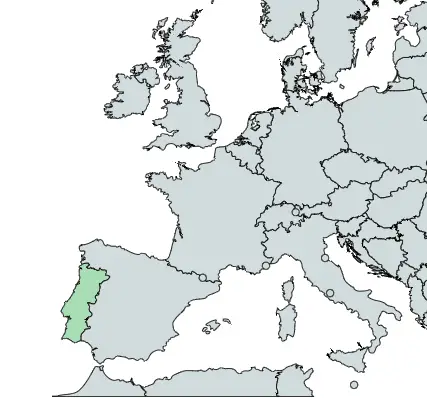
Responsible entity
The National Water Resources Information System (SNIRH) (Fig. 1) was initially developed within the Portuguese Water Institute (INAG). This was the institution within the Portuguese National Protection Action Scheme that coordinated water management.

In 2012 INAG was integrated in the Portuguese Environment Agency – APA, which also acted at the national level but incorporated extended valences compared with extinct INAG. APA merges in one single entity the national and regional competencies for managing the water domain as well as other environmental components such as waste licencing. This merging aimed to define standardized national instruments and procedures looking into a more efficient service to citizens and companies (Lacerda et al., 2013).
Monitoring procedures of water status was made a priority in the institution. APA presently manages the following networks, all of them reporting to SNIRH:
- A meteorological network, consisting of 561 meteorological stations that measure precipitation, wind speed and direction, evaporation, radiation, temperature, humidity.
- A hydrometric network, consisting of 256 stream gauge stations that measure hydrometric levels.
- A piezometer network to measure the groundwater level comprising 602 stations.
- A groundwater quality network comprising 848 stations.
- A surface water quality network comprising about 2065 stations in rivers and reservoirs, assessing ecological and chemical status, and 213 stations to assess the status of transitional and coastal water bodies.
Detailed explanation
Technically, the National Water Resources Information System is a public web portal (https://snirh.apambiente.pt/) supported by a database that concentrates, stores and disseminates hydro-meteorological and water quality data, from both surface water and groundwater, collected by the Portuguese Ministry of the Environment’s water resources monitoring network.
The monitoring network consists of automatic and conventional stations, some of which are equipped with a remote transmission system. The web portal also publishes monthly water availability reports, technical summaries and cartography on water resources such as flood zones. The SNIRH database also encompasses technical documents and photographs related to water resources.
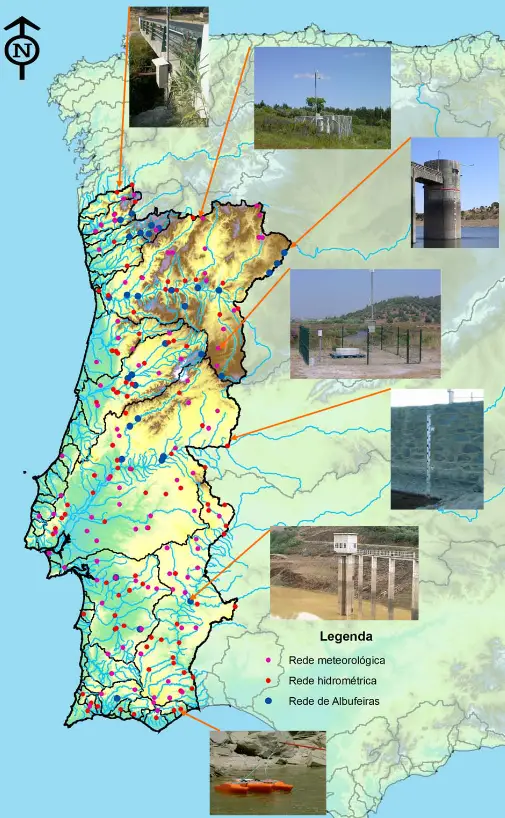
The web-portal presentation is divided into different sections: (1) Synthesized Data, (2) Base Data, (3) Big Numbers, (4) Media Library and (5) International Relations.
The Synthetized Data section is a report and information database which has a set of report bulletins related to rainfall, surface water flow, surface water storage, and temperature, and a special card dedicated to Groundwater, where static information regarding 22763 wells, 7964 of them with detailed information (depths, screening, geological profiles, etc.), is stored. Besides, the Groundwater card also provides reports. As an example, it allows the user to check the status of a specific groundwater body related both with quantity (groundwater depth) and quality (with parameters such as chlorides, nitrates or electrical conductivity) – Fig. 3. The system generates geostatistical surfaces based on point data gathered from the monitoring network.
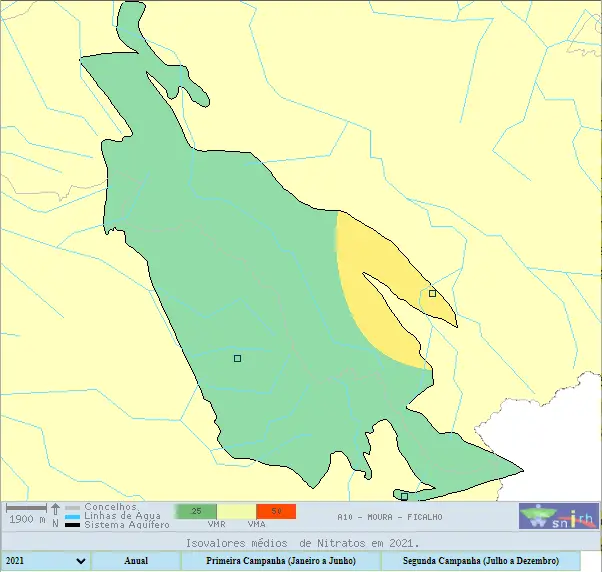
This Synthetized Data section also comprises reports on the coastal water quality status in the bathing season, surface water reservoir characteristics with detailed data of dam constructive aspects, groundwater wellhead protection areas and extreme events reports for drought and forest fires (reporting on effects on water quality, loss of soil and related flood events).
The Base Data section is divided into two main sub-sections: the raw data from the monitoring networks, including point data from surface and groundwater quality and quantity as well as meteorological data (which are used for generating reports in the Synthesized Data section), and the Floods Observatory.
The Floods Observatory has a surveillance system (SVARH) and includes a flood risk cartography database and reports. The Flood Surveillance and Warning System is a sub-set of the real-time global water resources management scheme (SVARH) and is composed of four components:
- Sensors and remote transmission.
- Protocol data from upstream country (Spain) and reservoir operation from hydropower companies.
- Hydrological and hydraulic models.
- IT systems for storing validating and broadcasting hydrometeorological data.
Rainfall forecasts and soil moisture evolution assumptions are used as the basis to model and generate hydrological and hydraulic forecasts. These forecasts are established for priority critical points/areas: (1) upstream flow to dam, (2) water levels for urban areas and (3) flow and water levels in the stream gauge stations (Fig. 4).
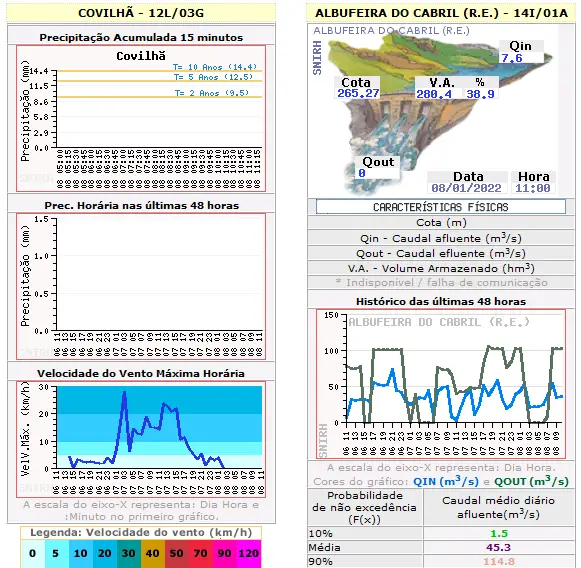
Although not yet visible in real-time, areal flooded surfaces are generated by coupling GIS capacities with the hydraulic forecasts.
In transboundary watersheds with Spain, all upstream relevant information is sent to Portugal in the framework of the Convenção de Albufeira Protocol. The SVARH uses an alert system that notifies the National Civil Protection Agency Center (Autoridade Nacional de Proteção Civil) and respective regional dependencies in case of an emergency.
Big Numbers section contains a Water Atlas, a geographical database of water characteristics of Portugal, divided by the main watersheds, from average evapotranspiration to soil types and uses. It also contains a detailed geological, hydrological and hydrogeological description of the Portuguese groundwater bodies.
The Media Library currently has five sub-sections: Hydro-library, Hydro-Album, Legislation, Glossary, and “What is SNIRH?”. Hydro-library is a public literature database with historically relevant documents on water resources in Portugal as well as a footage repository that integrates users’ contributions. Hydro-album is a collection of photos regarding the different themes of SNIRH, Legislation is an updated repository of Portuguese legislation related to water, since the year 1932. Glossary contains the definition of 315 terms related to water resources. And the “What is SNIRH?” sub-section contains a general description about SNIRH and claims that it is accessed more than 600 times a day by students, teachers, researchers, educational establishments, designers and consultants, companies, social media and central and regional public administration.
Finally, the International Relations section presents detailed information on the transboundary Albufeira Protocol as well as European and Portuguese Legal Framework summaries and briefs, such as the Nitrates Directive 91/676/CEE reports.
The web portal allows the user to directly search for a specific monitoring station (with a given reference code), explore the raw data and download workable CSV files. Within each station card, it is possible to check statistics on monitored parameters or generate the temporal evolution graph for specific parameters (Fig. 5).
The user can use the public platform to clarify doubts related to water resources.
From the SNIRH main page the SNIRH-Junior, the user can also access a secondary web portal whose educational contents are directed to children, including didactic games and online galleries for the presentation of teaching articles related to water resources.
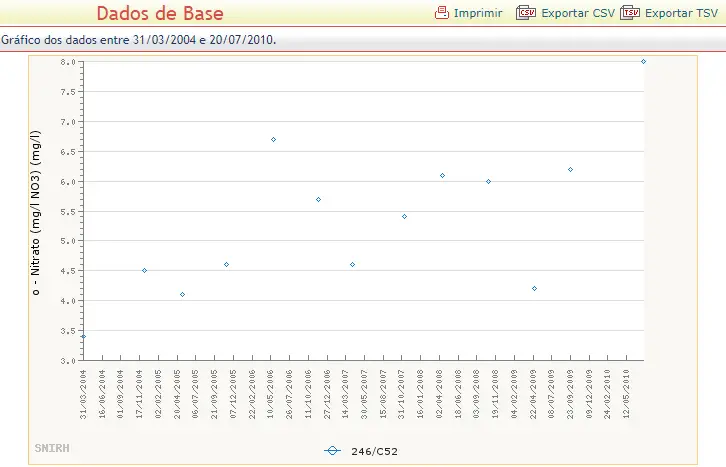
Institutional setting
The European Union Water Framework Directive (WFD) was adopted in 2000 with the objective of establishing a framework for Community action in the field of water policy. This extensive and pioneering European legislation aims to protect and enhance aquatic ecosystems and promote sustainable water use in European territories. It sets the framework for analysis planning and management of water resources by establishing environmental objectives for water bodies to achieve good ecological status by 2027. It also defines the creation of management mechanisms such as the River Basin Management Plans to identify and assess pressures to the water bodies and specify measures’ programs (Carvalho et al., 2019; Collins et al., 2012) Most importantly, the directive established the requirements for monitoring the surface water and groundwater status and protected areas (Article 8) as well as the specific parameters to be considered (European Commission, 2003).
At the national scale, the WFD was transposed into the “Portuguese Water Law”, which aimed to prevent further degradation and protect and improve the status of aquatic ecosystems, promote sustainable use of water, based on the long-term protection of available water resources, mitigate the effects of floods and droughts, and ensure a sufficient supply of good quality surface and groundwater, for sustainable, balanced and equitable use of water.
The transposition of the WFD to the National legal framework represented an opportunity to modernise and increase the geographical extension of the already existing Portuguese monitoring networks. Although SNIRH is older than the WFD and “PT Water Law”, this public database is the perfect platform to store and make available to the public monitoring data.
Geographical setting
SNIRH monitoring networks cover the entire Portuguese mainland territory (Fig. 2) and includes hydrological and meteorological data for Azores and meteorological data for Madeira islands. This system is particularly relevant in monitoring extreme events such as droughts and floods, which are expected to be more recurrent with climate change.
Historical overview
The National Water Resources Information System (SNIRH) was created by the Water Institute (INAG) in 1995 and launched officially on the Portuguese Water Day, October 1st, 1997. It was in fact the 1990-1995 drought period (which was ended by the heavy floods period in 1995/96) that forced the necessity to create hydrometeorological automatic systems to allow authorities to provide a proper and immediate response. Between 1996 to 1998 several types of equipments were tested which laid the guidelines for establishing the Portuguese monitoring networks, which were fully operational at the beginning of the XXI century (Lacerda, et al., 2013).
In 2000, the Portuguese-Spanish relations concerning Water Resources was discussed and outlined within the Cooperation Convention for the Protection and Sustainable Use of Water from Portuguese-Spanish River Basins, also known as Convenção de Albufeira (Albufeira Protocol). It integrates the Water Framework Directive guidelines, creating a cooperation and coordination protocol for the protection of water bodies, aquatic and terrestrial ecosystems, aiming for the joint sustainable use of water resources. This represented an important step in sharing information between the two countries, feeding the SNIRH and allowing for forecasts in transboundary watersheds.
In 2012, the Portuguese Environment Agency (APA), which integrated INAG valences, was created. SNIRH web portal is since then managed by APA which is also the technical organism that currently supervises the Convenção de Albufeira cooperation protocol and integrates transboundary data within the portal database.
Evidence of benefits from implementation
One of the most relevant benefits of SNIRH is the acquisition and inclusion of telemetric stations, which remotely send information in real-time and allow for decision-makers and emergency responders to take quick action in case of adverse conditions.
SNIRH databases have been also contributing greatly to the water scientific research that is conducted in Portugal. Once the platform was open to public access there was an internal discussion related to the possible commercialization of available data. INAG then took a pioneering initiative establishing free access to environmental data. This allowed the recently developed web interface to be distinguished in 1997 by the Descartes Award, promoted by the Portuguese Institute of Informatics in the category of “Provision of information on Water Resources via the Internet”.
On that note, the SVARH has also received the 3rd Prize, in the Management category, of the Microsoft Software Contest in 2003.
Today SNIRH continues to allow the use of published content as long as the source is cited.
Replication potential in SUDOE region
Systems like SNIRH exist also in Spain and France and are fully operative and reporting on water bodies ecological status based on monitoring data.
Similar to SNIRH, other smaller monitoring and reporting platforms were also assembled in Portugal, with specific purposes. As an example, the Portuguese Irrigation Technology and Operational Center (COTR) has established the SAGRA (Agrometeorological System for Irrigation Management in Alentejo). Given the strategic importance of the Alqueva surface water reservoir for agricultural uses, a platform that helps the management of irrigation water was established with a set of 14 automatic meteorological stations that determine the actual evapotranspiration in the Alentejo region, southern Portugal (Fig. 6). The main difference to SNIRH is that access is restricted to CODR associated members.
Future outlook
The web portal is currently in the Portuguese language only. The interface would benefit from some updates and modernization. Some improvements were conducted to achieve portal compatibilization for portable devices, but still lacks some of the functionalities of the PC web browser versions, allowing the user only to observe brief reports on precipitation, gauge stations and dams.
In the near future, important technological innovations are expected to be implemented in the monitoring procedures, which ultimately will end up in significant changes in platforms like SNIRH. Through questionnaire analysis of almost 100 experts, it was pointed out that EU member states should look into including new technologies, which have become available in recent years, in monitoring programs. The use of satellite data for surveillance and operational monitoring may allow for increased frequency and spatial coverage. It is also noted that those methods coupled with machine learning, improved sensor technologies and citizen science concepts may greatly enhance monitoring with effective cost reduction and increased data quality/precision (Carvalho et al., 2019).
It is expected that SNIRH may suffer significant changes to keep up with those technological advances.
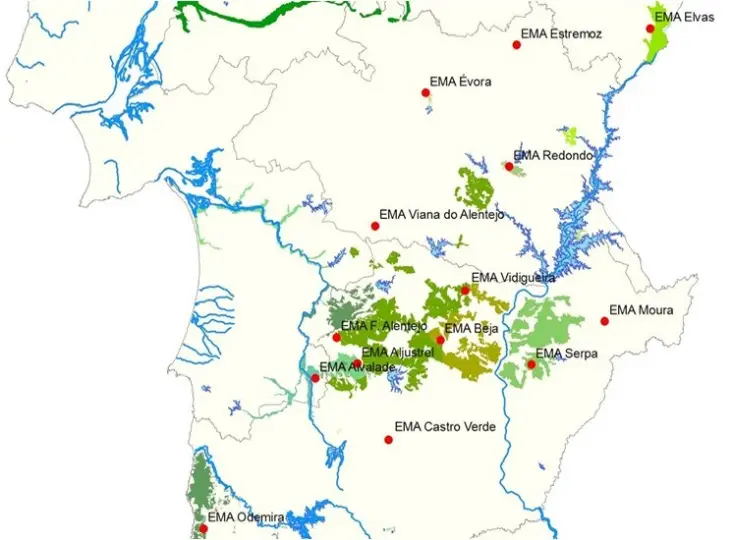
Key points of the innovative method
- The National Water Resources Information System (SNIRH) is a web public web-portal that allows the user to access data related to water resources in Portugal mainland, Azores and Madeira.
- The system is comprised of 14 independent monitoring networks including meteorological, surface water and groundwater data
- SNIRH includes a vast collection of water resources related documents including historical photographs.
- SNIRH reports on extreme events situations such as droughts and includes a flooding alert system (SVARH)
- Although fully operational, the SNIRH web-portal is currently showing some signs of an ageing web-interface
- Due to specific operational problems, the information from some monitoring stations may take a few months to become available.
- A significant amount of historical hydrometeorological data can be consulted and be used freely in water-related research.
Acknowledgements
This innovative practice was suggested by Miguel Carrinho from Águas do Ribatejo, SA, Portugal.
References
Carvalho, L., Mackay, E.B., Cardoso, A.C., Baattrup-Pedersen, A., Birk, S., Blackstock, K.L., Borics, G., Borja, A., Feld, C.K., Ferreira, M.T., Globevnik, L., Grizzetti, B., Hendry, S., Hering, D., Kelly, M., Langaas, S., Meissner, K., Panagopoulos, Y., Penning, E., Rouillard, J., Sabater, S., Schmedtje, U., Spears, B.M., Venohr, M., van de Bund, W., Solheim, A.L., 2019. Protecting and restoring Europe’s waters: An analysis of the future development needs of the Water Framework Directive. Science of The Total Environment 658, 1228–1238. https://doi.org/10.1016/j.scitotenv.2018.12.255
Collins, A., Ohandja, D.-G., Hoare, D., Voulvoulis, N., 2012. Implementing the Water Framework Directive: a transition from established monitoring networks in England and Wales. Environmental Science & Policy 17, 49–61. https://doi.org/10.1016/j.envsci.2011.11.003
European Commission, 2003. Common Implementation Strategy for the Water Framework Directive (2000/60/EC), Guidance Document No. 7 – Monitoring under the Water Framework Directive. ISBN 92-894-5127-0, ISSN 1725-1087. https://circabc.europa.eu/sd/a/056087d4-1b83-4504-9905-160c6cac7deb/GD%2007%20-%20Monitoring%20-%20Policy%20Summary.pdf
Lacerda, M., Lacasta, N., Rodrigues, R., Brandão, C., Saramago, M., 2013. As Redes de Monitorização como Instrumentos Imprescindíveis ao Conhecimento e Gestão dos Recursos Hídricos. Boletim Informativo APRH N.º 146. https://www.aprh.pt/bi/pdf/bi146.pdf
INTERNET REFERENCES:
SNIRH web portal (https://snirh.apambiente.pt/)
Portuguese National Water Law (https://apambiente.pt/agua/lei-da-agua)
Convenção de Albufeira transboundary cooperation agreement (https://apambiente.pt/agua/convencao-de-albufeira-cooperacao-luso-espanhola)
SNIRH flyer (https://snirh.apambiente.pt/snirh/download/relatorios/SNIRH_folheto_16_01_2006.pdf)
SVARH Flood Surveillance and Warning System brochure (https://snirh.apambiente.pt/snirh/download/relatorios/Folheto_PT_EN_FINAL.pdf)
COTR-SAGRA brief description (http://www.cotr.pt/servicos/sagra.php)
APA’s SNIRH brief description (https://apambiente.pt/agua/sistema-nacional-de-informacao-de-recursos-hidricos-snirh)
Other sources:
https://snirh.apambiente.pt/snirh/download/relatorios/Livro_REDES_net.pdf
https://snirh.apambiente.pt/snirh/download/relatorios/monitoricao_recursohidricos2.pdf
Participating members:
Portuguese Environmental Agency (APA) (https://apambiente.pt/)
aquifer
news
Discover more on the Aquifer project news and on aquifer management
aquifer news
Description and objectives of the project
The scientific community recommends a substantial improvement in the knowledge of aquifers, the establishment of reliable monitoring networks and a greater involvement of the administration and users to achieve a sustainable management of aquifers. The main objective...
Information on the project
The Llobregat Delta Water Users' Community has designed recharge basins in Molins de Rei to recharge the Baix Llobregat aquifer. View of one of the reloading basins during the test phase The Llobregat Delta Water Users' Community is one of the nine partners in the...
Success stories in groundwater management
Compilation of groundwater management success stories completed. Throughout April, the 30 cases of innovative practices in groundwater management have already been selected by the clusters participating in the project: PPA, CWP and AV. The task started with the...
PROPOSE AN
INNOVATIVE PRACTICE
You are in charge of an innovative practice regarding aquifer management and you want to referenced it on the Aquifer platform ?
Fulfill the form and propose it to the Aquifer partners.
THE EBOOK
Aquifer offers a range of innovative water management practices. You can download all our fact sheets here.
e-book of innovative practices
DOCUMENTATION
To go further on information related to the management of aquifers